Air Quality at Your Street 2.0—Air Quality Modelling for All Streets in Denmark
Abstract
1. Introduction
- (1)
- How accurately does the Air Quality at Your Street 2.0 model predict annual mean concentrations of NO2, PM2.5, PM10, Black Carbon (BC), and particle number concentration (PNC) across Danish addresses compared to national monitoring data?
- (2)
- What are the major sources of uncertainty in the modelling system, and how do they affect the accuracy of air quality predictions?
2. Materials and Methods
2.1. Evaluation of Traffic Volumes and Speeds
2.2. Measurements for Evaluation of Model Results
3. Results and Discussion
3.1. Evaluation of Model Results in 2019
3.2. Geographic Distribution of Background and Street Concentrations for NO2
3.3. Comparison with Limit Values and WHO Guidelines and Trends in Exceedance from 2012 to 2019
3.4. Comparison with Similar Systems
3.5. Potential Transferability and Scalability
3.6. Limitations of Model System
4. Conclusions
Supplementary Materials
Author Contributions
Funding
Data Availability Statement
Acknowledgments
Conflicts of Interest
References
- European Union. Directive (EU) 2024/2881 of The European Parliament and of the Council of 23 October 2024 on ambient air quality and cleaner air for Europe (recast). Off. J. Eur. Union. 20 November 2024. Available online: https://eur-lex.europa.eu/eli/dir/2024/2881/oj/eng (accessed on 20 November 2025).
- European Union. Directive 2008/50/EC of the European Parliament and of the Council of 21 May 2008 on Ambient Air Quality and Cleaner Air for Europe. Off. J. Eur. Union 2008, 152, 1–44. [Google Scholar]
- European Environmental Agency. European Air Quality Index, 18 November 2021. Available online: https://www.eea.europa.eu/themes/air/air-quality-index (accessed on 20 November 2025).
- Jensen, S.S.; Ketzel, M.; Becker, T.; Christensen, J.; Brandt, J.; Plejdrup, M.S.; Winther, M.; Nielsen, O.-K.; Hertel, O.; Ellermann, T. High Resolution Multi-scale Air Quality Modelling for All Streets in Denmark. Transp. Res. Part D Transp. Environ. 2017, 52, 322–339. [Google Scholar] [CrossRef]
- Rich, J.; Hansen, C.H. The Danish National Passenger Model. Eur. J. Transp. Infrastruct. Res. 2015, 1–29. [Google Scholar] [CrossRef]
- Jensen, S.S.; Ketzel, M.; Khan, J.; Valencia, V.H.; Brandt, J.; Christensen, J.H.; Frohn, L.M.; Nielsen, O.-K.; Plejdrup, M.S.; Ellermann, T. Air Quality At Your Street 2.0; Scientific Report from DCE No. 445; DCE—Danish Centre for Environment and Energy, Aarhus University: Aarhus, Denmark, 2021; 62p. [Google Scholar]
- Brandt, J.; Silver, J.D.; Frohn, L.; Geels, C.; Gross, A.; Hansen, A.B.; Hansen, K.M.; Hedegaard, G.B.; Skjøth, C.A.; Villadsen, H.; et al. An integrated model study for Europe and North America using the Danish Eulerian Hemispheric Model with focus on intercontinental transport. Atmos. Environ. 2012, 53, 156–176. [Google Scholar] [CrossRef]
- Christensen, J.H. The Danish Eulerian Hemispheric Model—A three-dimensional air pollution model used for the Arctic. Atmos. Environ. 1997, 31, 4169–4191. [Google Scholar] [CrossRef]
- Frohn, L.M.; Christensen, J.H.; Brandt, J.; Hertel, O. Development of a high resolution integrated nested model for studying air pollution in Denmark. Phys. Chem. Earth B 2001, 26, 769–774. [Google Scholar] [CrossRef]
- Brandt, J.; Christensen, J.H.; Frohn, L.M.; Berkowicz, R. Air pollution forecasting from regional to urban street scale––Implementation and validation for two cities in Denmark. Phys. Chem. Earth 2003, 28, 335–344. [Google Scholar] [CrossRef]
- Frohn, L.M.; Geels, C.; Andersen, C.; Andersson, C.; Bennet, C.; Christensen, J.H.; Im, U.; Karvosenoja, N.; Kindler, P.A.; Kukkonen, J.; et al. Evaluation of multidecadal high-resolution atmospheric chemistry transport modelling for exposure assessments in the continental Nordic countries. Atmos. Environ. 2022, 290, 119334. [Google Scholar] [CrossRef]
- Berkowicz, R. OSPM—A parameterised street pollution model. Environ. Monit. Assess. 2000, 65, 323–331. [Google Scholar] [CrossRef]
- Ketzel, M.; Jensen, S.S.; Brandt, J.; Ellermann, T.; Olesen, H.R.; Berkowicz, R.; Hertel, O. Evaluation of the Street Pollution Model OSPM for Measurements at 12 Streets Stations Using a Newly Developed and Freely Available Evaluation Tool. J. Civ. Environ. Eng. 2013, S1, 1–11. [Google Scholar] [CrossRef]
- Ketzel, M.; Berkowicz, R.; Hvidberg, H.; Jensen, S.S.; Raaschou-Nielsen, O. Evaluation of AirGIS—A GIS-Based Air Pollution And Human Exposure Modelling System. Int. J. Environ. Pollut. 2011, 47, 226–238. [Google Scholar] [CrossRef]
- Khan, J.; Kakosimos, K.; Raaschou-Nielsen, O.; Brandt, J.; Jensen, S.S.; Ellermann, T.; Ketzel, M. Development and Performance Evaluation of New AirGIS—A GIS Based Air Pollution and Human Exposure Modelling System. Atmos. Environ. 2019, 198, 102–121. [Google Scholar] [CrossRef]
- Skamarock, W.C.; Klemp, J.B.; Dudhia, J.; Gill, D.O.; Barker, D.; Duda, M.G.; Powers, J.G. A Description of the Advanced Research WRF Version 3; No. NCAR/TN-475+STR; University Corporation for Atmospheric Research; Mesoscale and Microscale Meteorology Division, National Center for Atmospheric Research: Boulder, CO, USA, 2008. [Google Scholar] [CrossRef]
- Nielsen, O.-K.; Plejdrup, M.S.; Winther, M.; Mikkelsen, M.H.; Nielsen, M.; Gyldenkærne, S.; Fauser, P.; Albrektsen, R.; Hjelgaard, K.H.; Bruun, H.G.; et al. Annual Danish Informative Inventory Report to UNECE. Emission Inventories from the Base Year of the Protocols to Year 2018; Scientific Report No. 369; DCE—Danish Centre for Environment and Energy, Aarhus University: Aarhus, Denmark, 2020; 559p. [Google Scholar]
- Plejdrup, M.S.; Nielsen, O.-K.; Brandt, J. High resolution gridding of emissions from residential wood combustion in Denmark. Atmos. Environ. 2016, 144, 389–396. [Google Scholar] [CrossRef]
- Plejdrup, M.S.; Nielsen, O.-K.; Gyldenkærne, S.; Bruun, H.G. Spatial High-Resolution Distribution of Emissions to Air—SPREAD 3.0; Technical Report No. 215; DCE—Danish Centre for Environment and Energy, Aarhus University: Aarhus, Denmark, 2021; 208p. [Google Scholar]
- Geels, C.; Winther, M.; Andersson, C.; Jalkanen, J.-P.; Brandt, J.; Frohn, L.M.; Im, U.; Leung, W.; Christensen, J.H. Projections of shipping emissions and the related impact on air pollution and human health in the Nordic region. Atmos. Chem. Phys. 2021, 21, 12495–12519. [Google Scholar] [CrossRef]
- EMEP/EEA. Air Pollutant Emission Inventory Guidebook 2019; EEA Report 13/2019; EMEP/EEA: Copenhagen, Denmark, 2019. [Google Scholar]
- Frohn, L.M.; Ketzel, M.; Christensen, J.H.; Brandt, J.; Im, U.; Massling, A.; Andersen, C.; Plejdrup, M.S.; Nielsen, O.-K.; Manders, A.; et al. Modelling ultrafine particle number concentrations at address resolution in Denmark from 1979 to 2018—Part 1: Regional and urban scale modelling and evaluation. Atmos. Environ. 2021, 264, 118631. [Google Scholar] [CrossRef]
- Ketzel, M.; Frohn, L.M.; Christensen, J.H.; Brandt, J.; Massling, A.; Andersen, C.; Im, U.; Jensen, S.S.; Khan, J.; Nielsen, O.-K.; et al. Modelling ultrafine particle number concentrations at address resolution in Denmark from 1979 to 2018—Part 2: Local and street scale modelling and evaluation. Atmos. Environ. 2021, 264, 118633. [Google Scholar] [CrossRef]
- Ellermann, T.; Nordstrøm, C.; Brandt, J.; Christensen, J.; Ketzel, M.; Massling, A.; Bossi, R.; Frohn, L.M.; Geels, C.; Jensen, S.S.; et al. Air Quality 2019. Status for the National Air Quality Monitoring; Scientific Report No. 410; DCE—Danish Centre for Environment and Energy, Aarhus University: Aarhus, Denmark, 2021; (In Danish with English Summary). [Google Scholar]
- Jensen, S.S.; Ketzel, M.; Im, U.; Løfstrøm, P.; Poulsen, M.B.; Monies, C.; Ellermann, T. Evaluation of the OML-Highway; Science Report No. 240; DCE—Danish Centre for Environmental and Energy, Aarhus University: Aarhus, Denmark, 2017; 49p. [Google Scholar]
- Nordstrøm, C.; Ellermann, T.; Brandt, J.; Christensen, J.; Ketzel, M.; Massling, A.; Bossi, R.; Frohn, L.M.; Geels, C.; Solvang Jensen, S.; et al. Air Quality 2023. Status for the National Air Quality Programme; Scientific report No. 627; DCE—Danish Centre for Environment and Energy, Aarhus University: Aarhus, Denmark, 2024; 158p, (In Danish with English Summary). [Google Scholar]
- Ellermann, T.; Massling, A.; Bossi, R.; Nordstrøm, C. The Particle Project 2021; Scientific Report No. 500; DCE—Danish Centre for Environment and Energy, Aarhus University: Aarhus, Denmark, 2022; 38p. [Google Scholar]
- WHO. WHO Global Air Quality Guidelines. Particulate Matter (PM2.5 and PM10), Ozone, Nitrogen Dioxide, Sulfur Dioxide and Carbon Monoxide; WHO: Geneva, Switzerland, 2021. [Google Scholar]
- Grundström, M.; Asker, C.; Segersson, D.; Wylde, H.A.; van Dongen EJakobsson, M.; Windmark, F. High Resolution Air Quality Modelling of NO2, PM10 and PM2.5 for Sweden. A National Study for 2019 Based on Dispersion Modelling from Regional Down to Street Canyon Level; Report Meteorology and Climatology No. 120; Swedish Meteorological and Hydrological Institute: Norrköping, Sweden, 2023; 76p. [Google Scholar]
- Brandt, J.; Silver, J.D.; Christensen, J.H.; Andersen, M.S.; Bønløkke, J.; Sigsgaard, T.; Geels, C.; Gross, A.; Hansen, A.B.; Hansen, K.M.; et al. Contribution from the ten major emission sectors in Europe to the Health-Cost Externalities of Air Pollution using the EVA Model System—An integrated modelling approach. Atmos. Chem. Phys. 2013, 13, 7725–7746. [Google Scholar] [CrossRef]
- Grell, G.A.; Dudhia, J.; Stauffer, D.R. A Description of the Fifth Generation Penn State/NCAR Mesoscale Model (MM5); NCAR Technical Note, NCAR/TN-398+STR; Mesoscale and Microscale Meteorology Division, National Centre for Atmospheric Research: Boulder, CO, USA, 1995; p. 114. [Google Scholar]
- Berger, J.; Walker, S.-E.; Denby, B.; Berkowicz, R.; Løfstrøm, P.; Ketzel, M.; Härkönen, J.; Nikmo, J.; Karppinen, A. Evaluation and inter-comparison of open road line source models currently in use in the Nordic countries. Boreal Environ. Res. 2010, 15, 319–334. [Google Scholar]
- Jensen, S.S.; Ketzel, M.; Khan, J. Mapping of Air Quality Along State Roads in Denmark; Scientific Report from DCE No. 537; DCE—Danish Centre for Environment and Energy, Aarhus University: Aarhus, Denmark, 2023; 51p, (In Danish with English Summary). [Google Scholar]
- Paunu, V.-V.; Karvosenoja, N.; Segersson, D.; López-Aparicio, S.; Nielsen, O.-K.; Plejdrup, M.S.; Thorsteinsson, T.; Niemi, J.V.; Vo, D.T.; Denier van der Gon, H.A.C.; et al. Spatial distribution of residential wood combustion emissions in the Nordic countries: How well national inventories represent local emissions? Atmos. Environ. 2021, 264, 118712. [Google Scholar] [CrossRef]


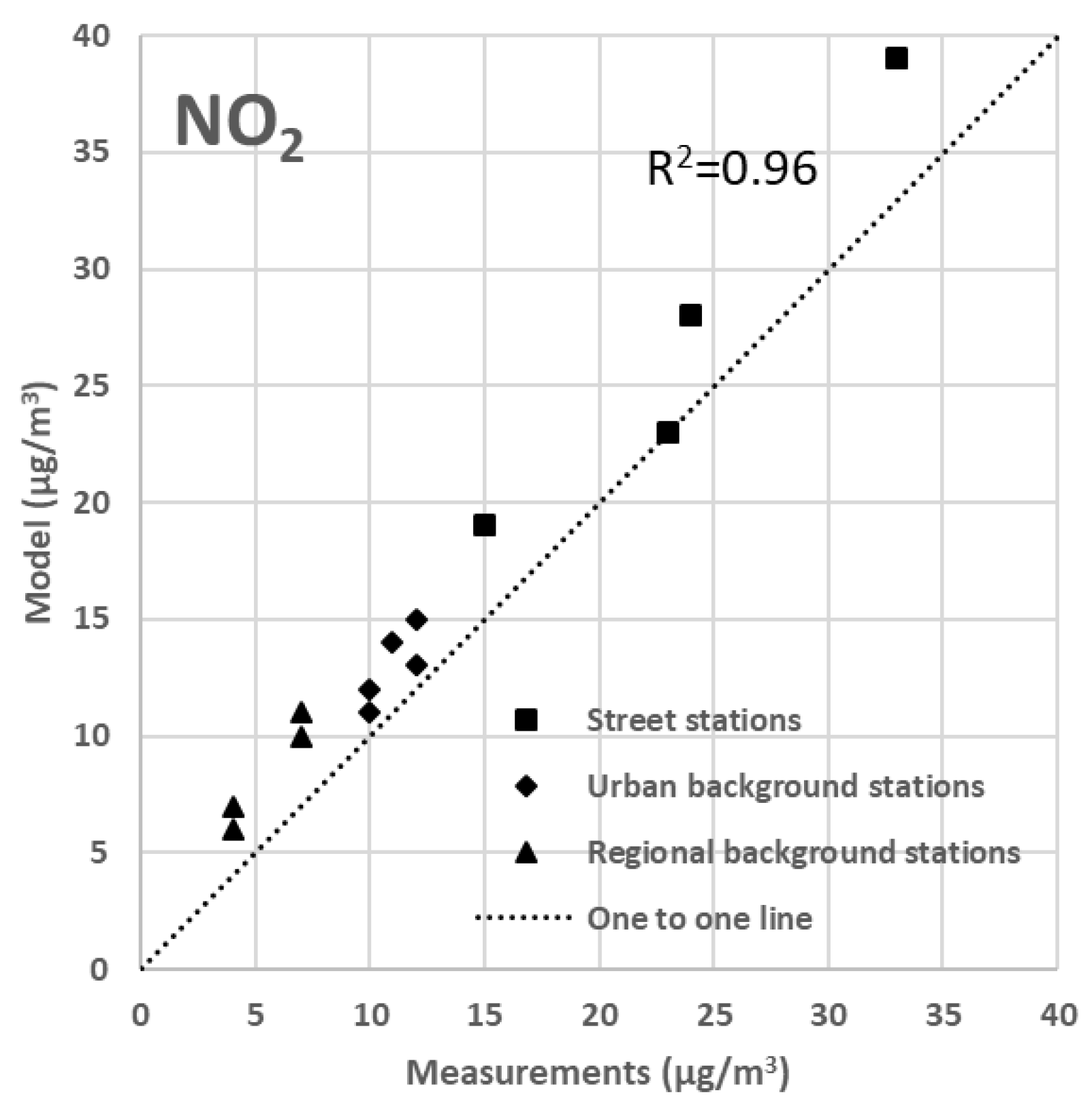
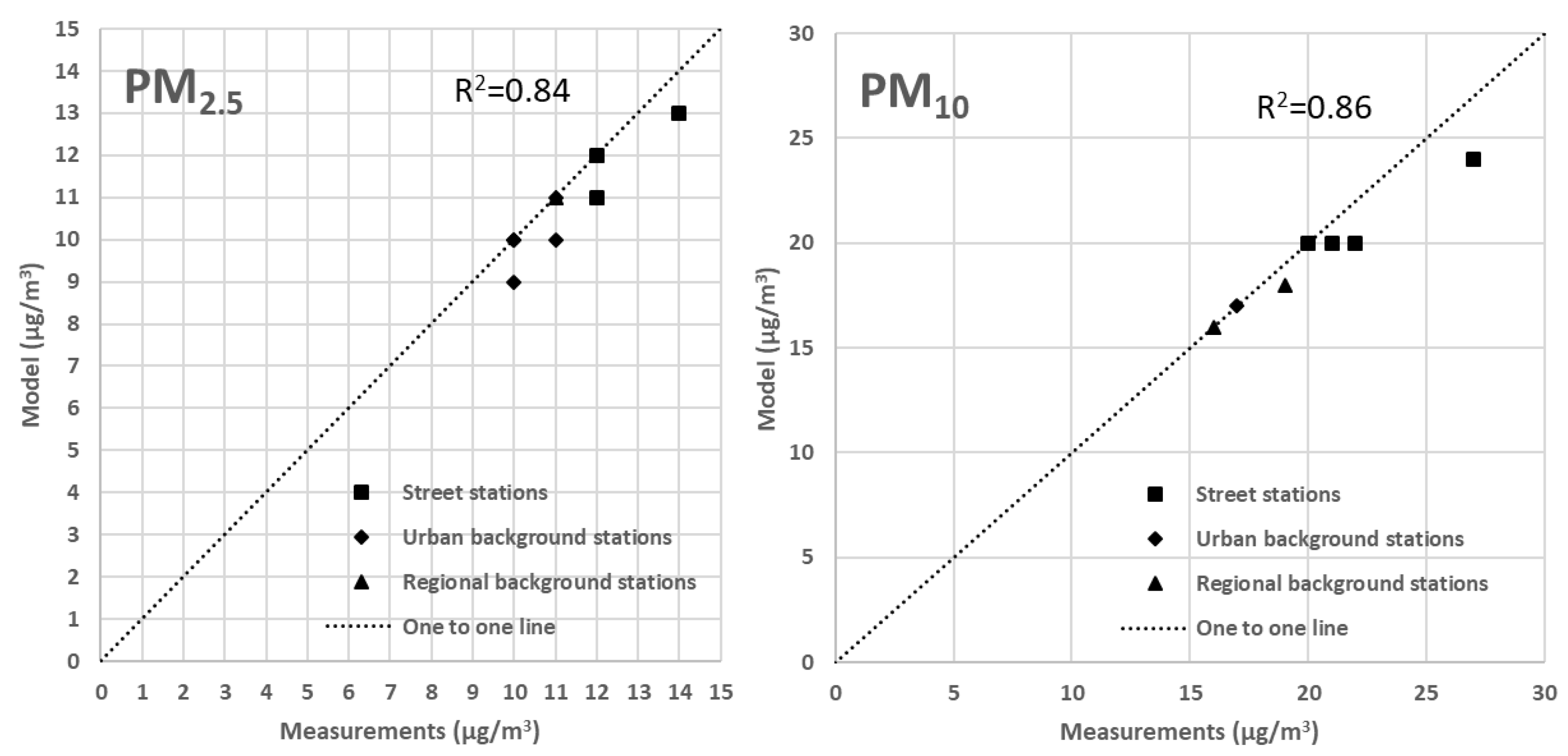
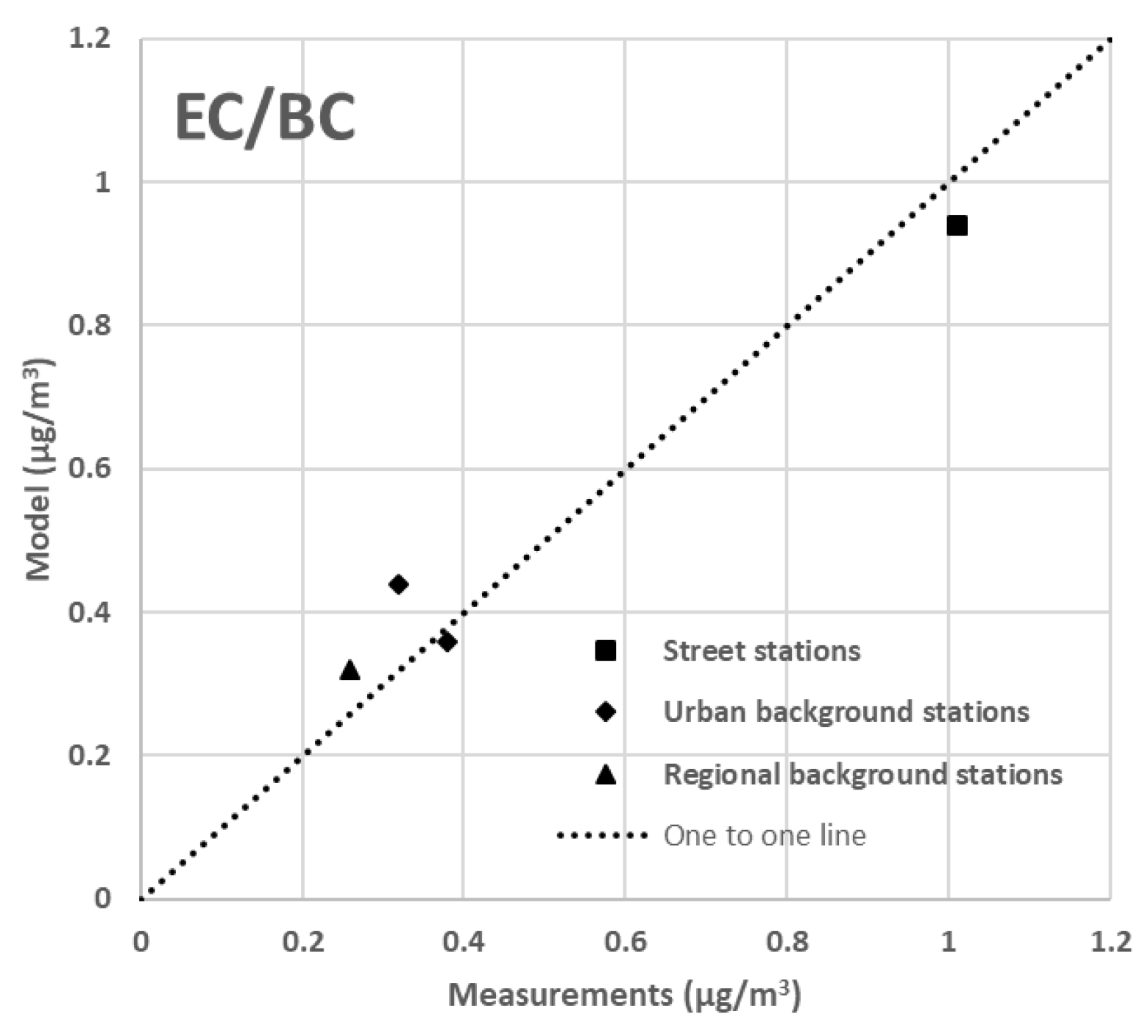

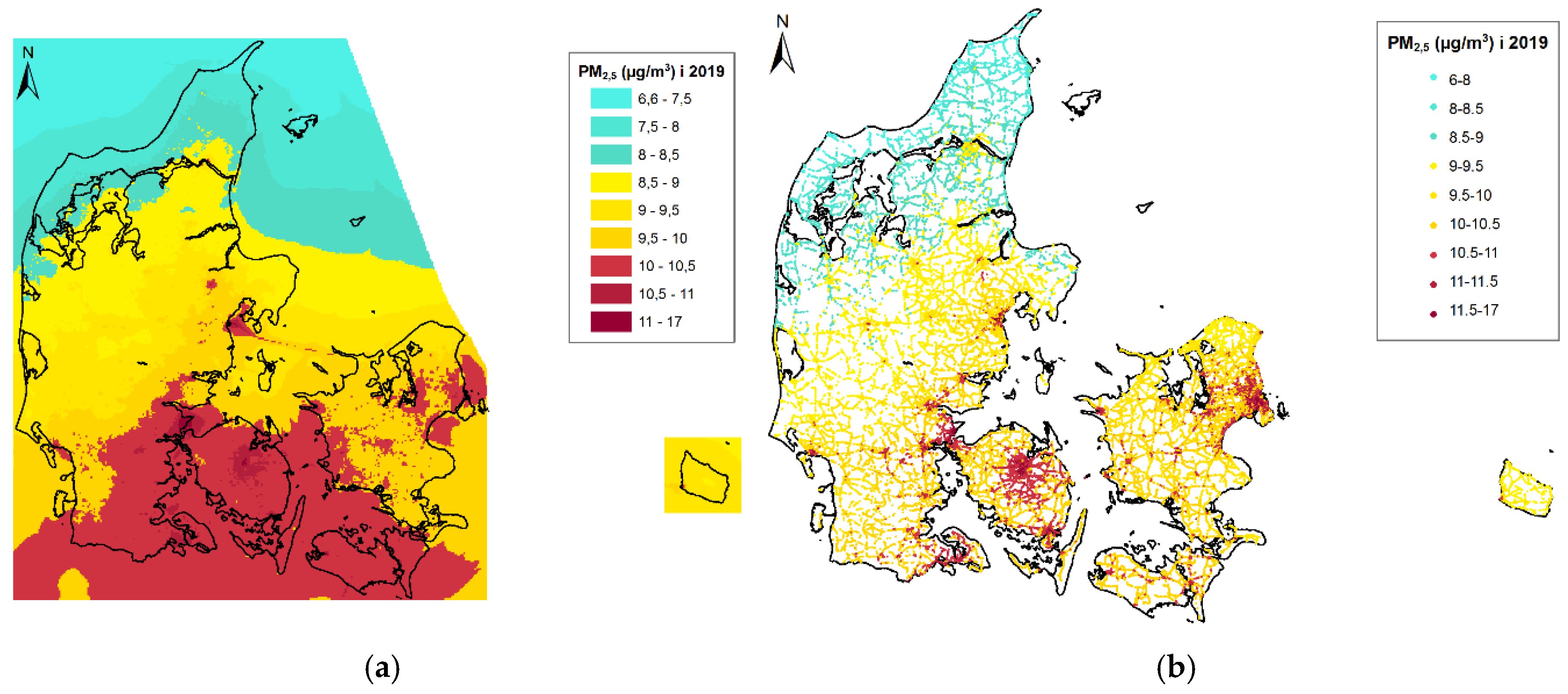
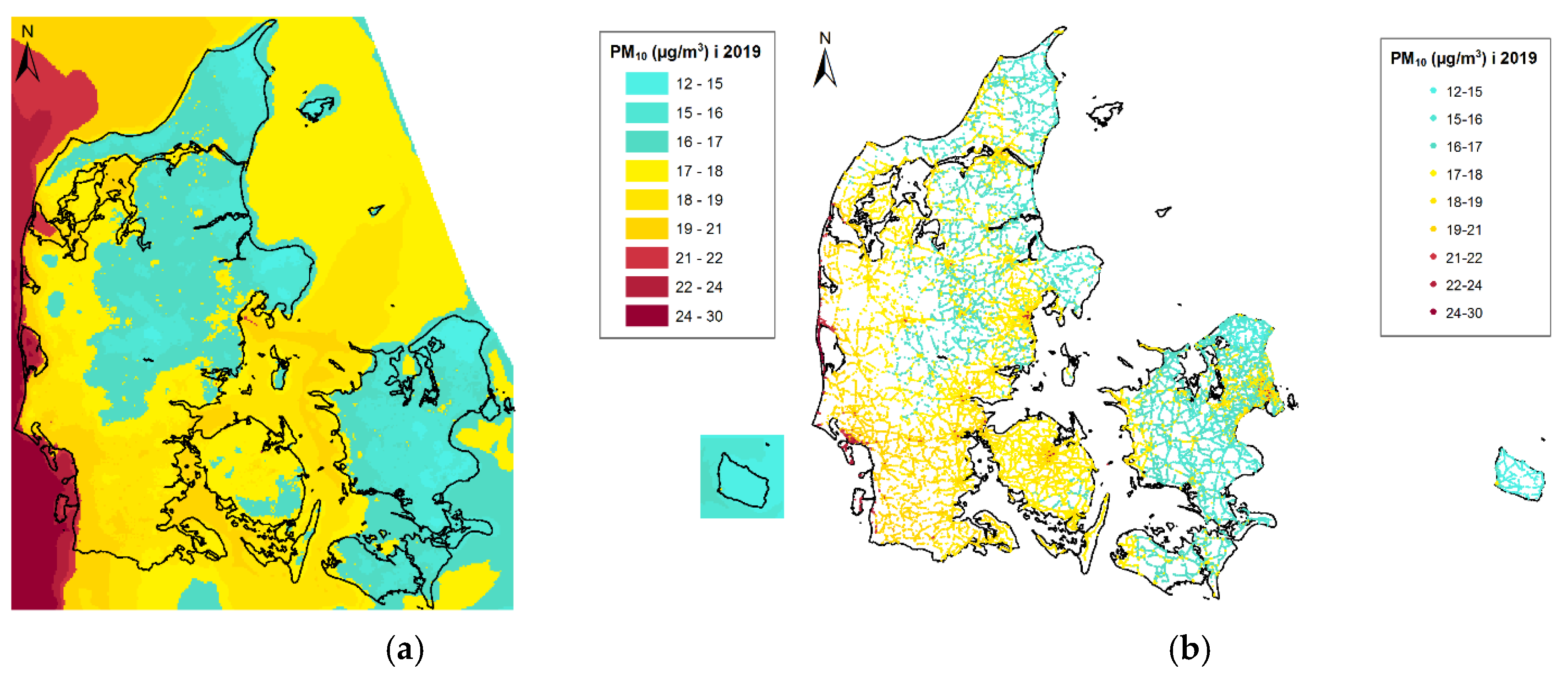
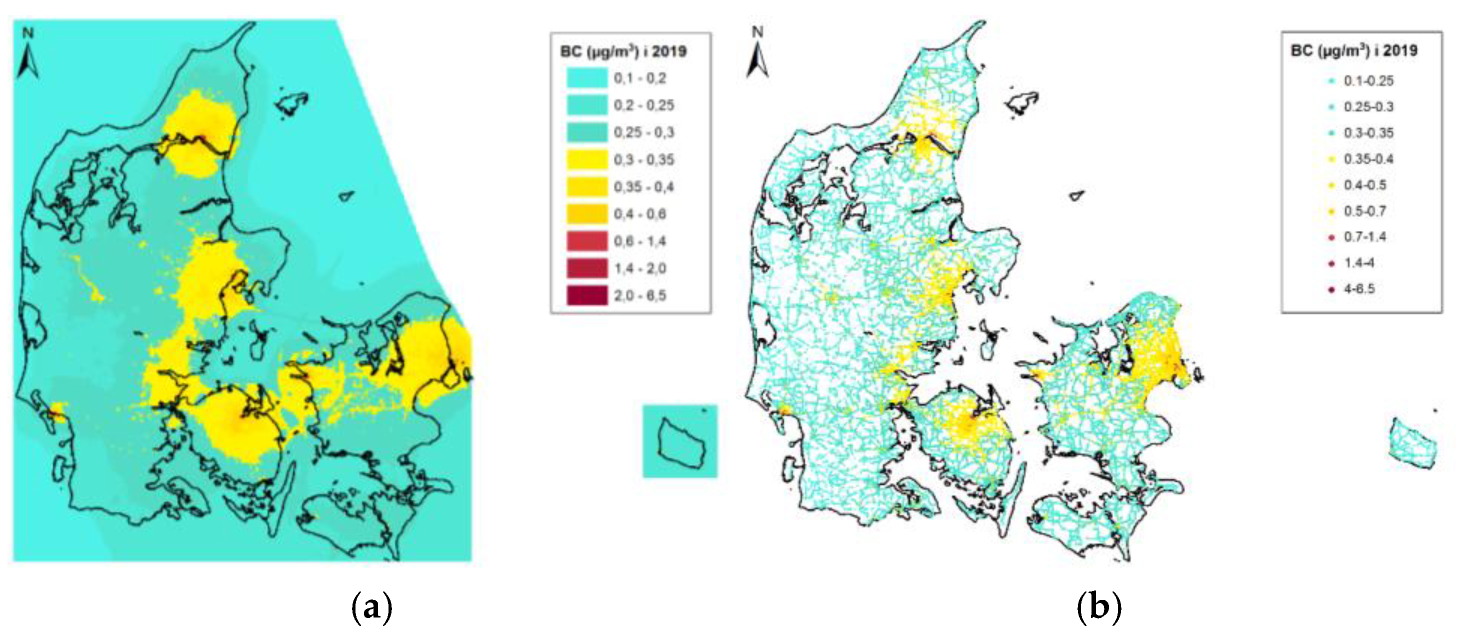
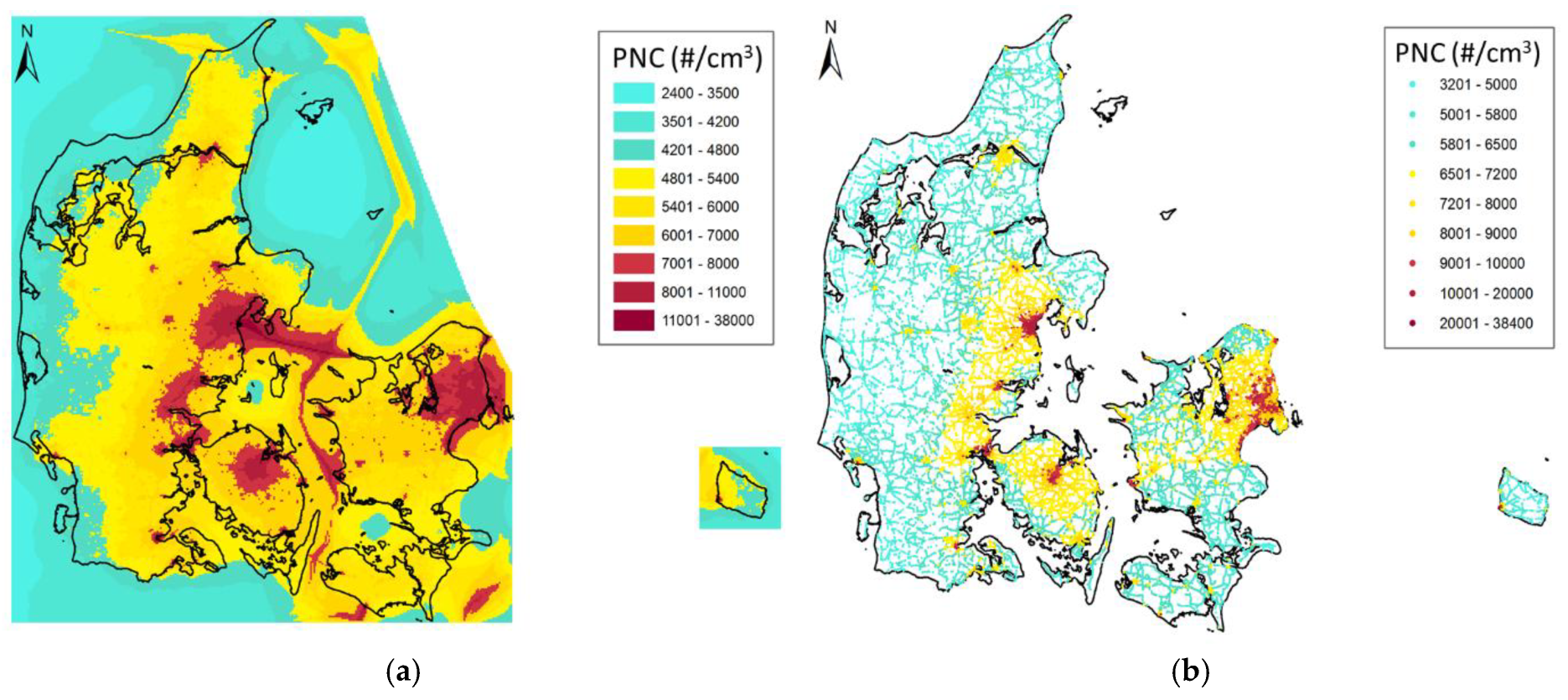

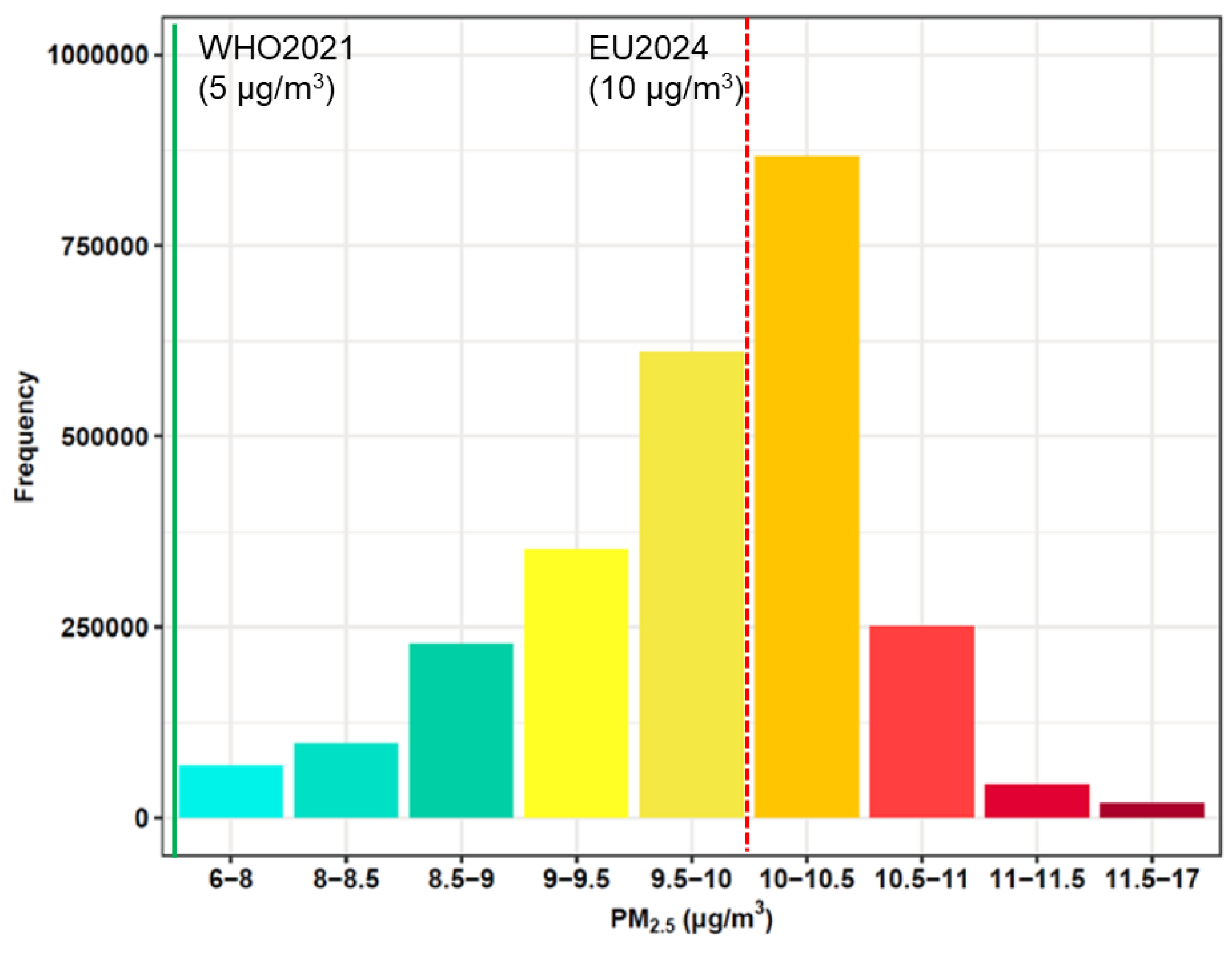

| Type | Version 1.0 | Version 2.0 |
|---|---|---|
| Model year | 2012 | 2019 |
| Chemistry transport models | DEHM/UBM/OSPM | DEHM/UBM/OSPM |
| Classical pollutants | NO2, PM2.5, PM10 | NO2, PM2.5, PM10 |
| New pollutants | n.a. | BC, PNC |
| Global and European emissions | EDGAR, GEIA, EMEP, EPITOME | EDGAR, GEIA, EMEP, EPITOME |
| Danish emissions | SPREAD 1 km × 1 km, COPERT for OSPM | SPREAD 1 km × 1 km, COPERT for OSPM |
| BC emissions | n.a. | International and Danish emission inventories |
| PNC emissions | n.a. | HERMES EU project |
| Mass closure adjustment | n.a. | Factor applied |
| Meteorological data | MM5 (2012) | WRF (2019) |
| National address dataset | 2.4 million | 2.5 million |
| National building footprints | From 2013 | From 2018 |
| National traffic flow data | GMM (2010) | GMM (2020) |
| Vehicle speed on road network | SPEEDMAP (2012) | SPEEDMAP (2016) |
| Evaluation of modelled traffic data against traffic counts | Copenhagen and Aalborg (2012) | Copenhagen and Aalborg (2019) |
| Evaluation of modelled concentrations against measurements | National monitoring network (2012) | National monitoring network (2019) incl. BC and PNC |
| Comparison with limit values and WHO | EU 2008 | EU 2008, 2024 and WHO 2021 |
| Trend analysis | n.a. | From 2012 to 2019 |
| Part of national AQ monitoring | n.a. | Since 2017 |
Disclaimer/Publisher’s Note: The statements, opinions and data contained in all publications are solely those of the individual author(s) and contributor(s) and not of MDPI and/or the editor(s). MDPI and/or the editor(s) disclaim responsibility for any injury to people or property resulting from any ideas, methods, instructions or products referred to in the content. |
© 2025 by the authors. Licensee MDPI, Basel, Switzerland. This article is an open access article distributed under the terms and conditions of the Creative Commons Attribution (CC BY) license (https://creativecommons.org/licenses/by/4.0/).
Share and Cite
Jensen, S.S.; Ketzel, M.; Khan, J.; Valencia, V.H.; Brandt, J.; Christensen, J.H.; Frohn, L.M.; Geels, C.; Nielsen, O.-K.; Plejdrup, M.S.; et al. Air Quality at Your Street 2.0—Air Quality Modelling for All Streets in Denmark. Atmosphere 2025, 16, 1346. https://doi.org/10.3390/atmos16121346
Jensen SS, Ketzel M, Khan J, Valencia VH, Brandt J, Christensen JH, Frohn LM, Geels C, Nielsen O-K, Plejdrup MS, et al. Air Quality at Your Street 2.0—Air Quality Modelling for All Streets in Denmark. Atmosphere. 2025; 16(12):1346. https://doi.org/10.3390/atmos16121346
Chicago/Turabian StyleJensen, Steen Solvang, Matthias Ketzel, Jibran Khan, Victor H. Valencia, Jørgen Brandt, Jesper H. Christensen, Lise M. Frohn, Camilla Geels, Ole-Kenneth Nielsen, Marlene Schmidt Plejdrup, and et al. 2025. "Air Quality at Your Street 2.0—Air Quality Modelling for All Streets in Denmark" Atmosphere 16, no. 12: 1346. https://doi.org/10.3390/atmos16121346
APA StyleJensen, S. S., Ketzel, M., Khan, J., Valencia, V. H., Brandt, J., Christensen, J. H., Frohn, L. M., Geels, C., Nielsen, O.-K., Plejdrup, M. S., & Ellermann, T. (2025). Air Quality at Your Street 2.0—Air Quality Modelling for All Streets in Denmark. Atmosphere, 16(12), 1346. https://doi.org/10.3390/atmos16121346








